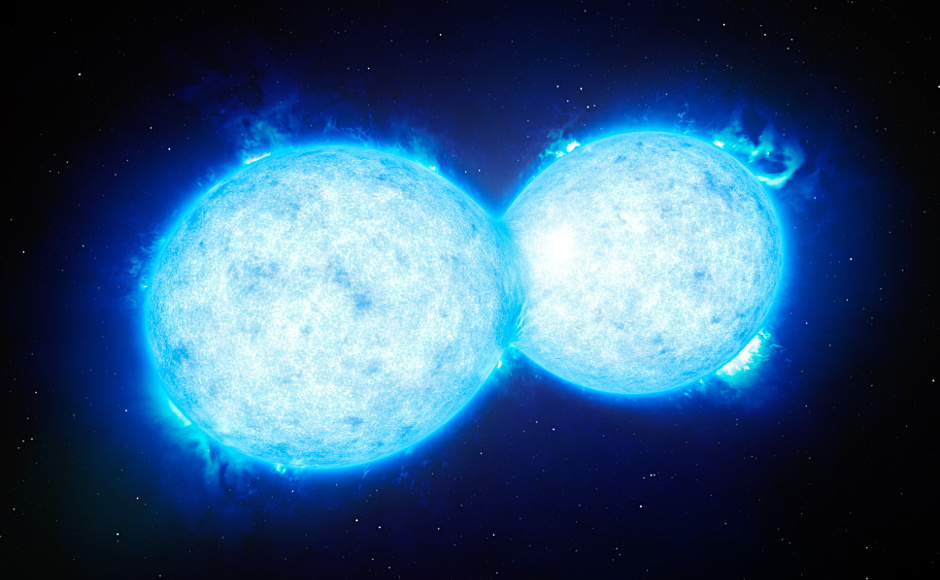Rare Merging Stars Spotted, Soon to Explode
Source: Newsweek
Rare Merging Stars Spotted, Soon to Explode
Douglas Main
7 hrs ago
Astronomers peering through the European Southern Observatory’s Very Large Telescope have spotted something extraordinarily rare: a double star, the surfaces of which have merged.
No double star quite like this has ever been seen, and it’s unusual to spot such a system because they are short-lived, the agency said in a release. Indeed, the double-star system—which is named VFTS 352 and located about 160,000 light years away in the Tarantula Nebula—will soon destroy itself in one of two ways, the scientists predict.
One possibility is that the two stars will merge, creating a super-massive, rapidly-rotating star. But this rotational energy will ultimately lead the system to become unstable. “If it keeps spinning rapidly it might end its life in one of the most energetic explosions in the universe, known as a long-duration gamma-ray burst,” said Hugues Sana, project lead scientist at Belgium’s University of Leuven. These types of explosions are the most powerful to have taken place since the big bang, according to Astronomy.com.
The second option is that the stars will stay “joined at the hip,” but not merge, and then separately explode on their own. “In the case of VFTS 352, the components would likely end their lives in separate supernova explosions, forming a close binary system of black holes,” or twin black holes, said theoretical astrophysicist Selma de Mink, from the University of Amsterdam.
Read more: http://www.msn.com/en-us/news/technology/rare-merging-stars-spotted-soon-to-explode/ar-BBmihtV?li=AAa0dzB&ocid=u142dhp
[center]
 [/center]
[/center]still_one
(92,055 posts)Nitram
(22,749 posts)Spitfire of ATJ
(32,723 posts)Check out this video that zooms in and you will get an idea of the immense distance involved:
longship
(40,416 posts)which is a satellite galaxy to the Milky Way. It is to the right in this picture. The other bright area is called the Small Magellanic Cloud (of course).

They are visible only south of the equator.
YabaDabaNoDinoNo
(460 posts)Don't forget we looking at the stars back in time, not real time.
BumRushDaShow
(128,257 posts)We are looking at what happened a long time ago in a galaxy far far away (although actually a bit closer than far far away). ![]()
Hoppy
(3,595 posts)Peace Patriot
(24,010 posts)...where we only have to worry about...well, quite a lot of things, including the violence and greed of many of our own species, and our inability to curtail their harm...but, still, compared to this HUMONGOUS collision in another galaxy, and many others similar to it, documented by our amazing astronomers, our corner of it all is, indeed, very quiet, and, as far as we know, will remain quiet for many more millions of years.
I suppose I should say that I DO know that supernovae are our ultimate 'grandparents.' From such extravagant cosmic violence come all of the elements of which we are made, and of which all life as we know it is made, here and everywhere else. All evidence points to the pervasiveness of life in our own Milky Way, and no doubt in most, or all, other galaxies. We haven't found other life yet, but we are only just acquiring the tools for the search, and what a spectacular beginning we have made--for instance, the recent discovery of about 5,000 candidate exoplanets (planets around other suns), with about 2,000 confirmations, in just a narrow sector of the Milky Way, in just the last few years; the discovery of earth-like planets that are over 11 billion years old, in the Milky Way (life and civilization could have come and gone there many times over); the discovery of water in one form or another all over the solar system, including probable huge oceans of it on the moons of Jupiter and Saturn and on Pluto.
Life as we know it is seeded by supernovae explosions. This one was very far away and very long ago, but, who knows, we might contain elements from that very event. Life also was likely seeded, locally, by collisions within our solar system, probably very spectacular collisions, of planets and asteroids, strewing microbes everywhere and creating the conditions for them to thrive. Our "little corner" hasn't always been quiet. We are--life is--the quiet after the storm, it seems.
FSogol
(45,425 posts)Kidding aside, cool photo, thanks for posting.